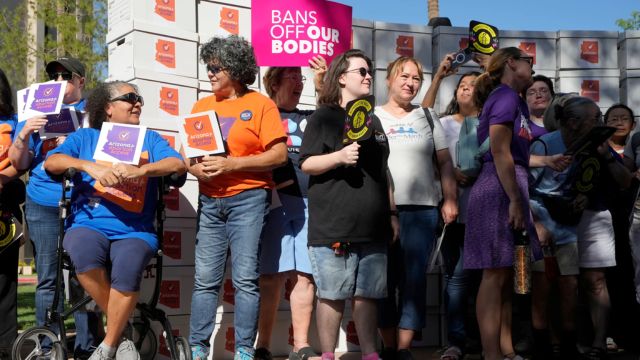In November, people in Arizona and Montana will be able to vote on whether to protect the right to an abortion in their state constitutions.
Tuesday, the Arizona Supreme Court said that a 200-word summary that supporters of abortion rights used to get people to sign a petition for a ballot measure is legal. This means that the issue will still be on the vote.
There were 577,971 valid signatures turned in to the Arizona secretary of state’s office last week, which is a lot more than the required number that the coalition backing the ballot measure had to turn in to put the question to voters.
Christi Jacobsen, the secretary of state for Montana, approved the constitutional proposal for the November ballot on Tuesday.
Both bills would allow abortions up until fetal viability, which is usually around 24 weeks and means the baby can live outside the womb.
There are some situations where a mother can get an abortion after the baby is viable in Arizona to save her life or protect her physical or mental health. The bill in Montana lets women have abortions later on if they need to protect their health or life.
The Montana measure would write into the state’s constitution a decision made by the state’s highest court in 1999. That decision said that a person’s constitutional right to privacy includes the right to get an abortion from any provider they choose. As Republicans passed bills to limit abortion rights, people who supported the right tried to protect it.
More than six states will have elections this fall to decide on abortion laws.
Abortion rights have been a big issue for Democrats ever since the U.S. Supreme Court rejected Roe v. Wade in 2022, and they are still a big part of their campaign this year.
Seven states have already held elections on abortion issues since then. These are California, Kansas, Kentucky, Michigan, Montana, Ohio, and Vermont. In all of them, voters chose to back abortion.
“Since Roe v. Wade was overturned, extreme anti-abortion politicians have used every trick in the book to take away our freedoms and ban abortion completely,” said Martha Fuller, president and CEO of Planned Parenthood of Montana. “During that time, we have been working together to put this issue before voters.”
New decisions from the Arizona Supreme Court came out before the deadline for casting ballots on Thursday. Montana’s vote needs to be checked by Thursday.
In a different case last week, Arizona’s judges agreed with Republican lawmakers that a voter information pamphlet could call an embryo or fetus an “unborn human being.” This case was related to the abortion ballot measure. That phrase will not be on the ballots.
Arizona Right to Life sued over the petition statement in the most recent case about an abortion measure, saying it was false.
The high court justices didn’t agree with that argument or the one that said the petition summary for the proposed amendment didn’t say that it would change current abortion laws if voters accepted it. “Reasonable people” can have different ideas about how to best explain a key part of an election measure, the court said in its decision, but the court shouldn’t get involved in those arguments.
“No matter what the ruling is, we look forward to continuing to work with our pro-life partners across the state to keep voters informed about this unclear language,” said Susan Haugland, a spokeswoman for Arizona Right to Life.
The group Arizona for Abortion Access, which started the initiative, called the decision a “huge win” and said they would be working nonstop to get people to vote for it.
“We are confident that this fall, Arizona voters will make history by establishing a fundamental right to abortion in our state, once and for all,” the group wrote in a statement.

